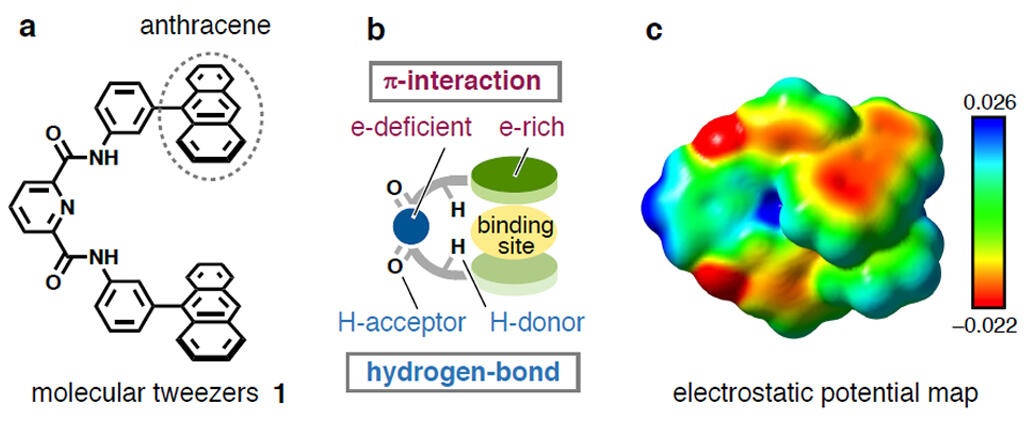A research group led by Assistant Professor Masahiro Yamashina, Professor Shinji Toyoda, graduate student Yuta Sawanaka (at the time of the research), and Assistant Professor Hiroyoshi Ohtsu (at the time of the research) of the Department of Chemistry, School of Science at Tokyo Institute of Technology, has successfully developed an original technique to construct artificial supramolecules by using molecular tweezers and principles seen in the capsid of viruses.

(b) Deformed view of the molecular tweezers and four interaction sites.
(c) Electrostatic potential map of 1. The area near the anthracene and oxygen atoms is rich in electrons (red), while the area near the fulcrum of the molecular tweezers is electron-deficient (blue).
Credit: Nature Communications
Rare metals are used as catalysts in various molecular syntheses, but methods to synthesize molecules without these metals have become socially important in recent years owing to soaring prices and the conservation of scarce resources. The research group focused on "self-complementarity assemblies", the principle seen in the molecules of the human immunodeficiency virus (HIV-1) and used the spontaneous assembly of tweezer-like anthracene (a fluorescent compound in which three benzene rings are linearly linked) based molecules to successfully construct highly selective cyclic assemblies.
The resulting ring has an unprecedented cylindrical structure of about 2 nanometers and is formed through repeated intermolecular interactions by six tweezer-like molecules. The ring showed strong blue fluorescence and high mechanical and thermal stability. Furthermore, under acidic conditions, the group found that 18 rings (108 monomeric tweezer units) aggregated to form a globular assembly of about 7 nanometers with a huge internal space similar to that of viruses.
"In future research, we would like to incorporate multiple organic and bio-related molecules in a spherical assembly with a large cavity to develop specific reactions combining isolated space and light," commented Assistant Professor Yamashina. "In a ring assembly, the photofunctional molecules (anthracene in this case) at the tips of the tweezers are precisely aligned in a cyclic manner. In other words, we intend to investigate performance as a light-harvesting antenna-complex for artificial photosynthesis."

Credit: Nature Communications
■ Molecular tweezers: Molecules shaped like tweezers. Two 'armed' molecules facing each other that can bind other molecules. They have been used as a classical supramolecular host.
■ Highly-selective: To preferentially obtain only certain molecules. In this study, the formation of 32 types of chain molecules in addition to the cyclic hexamer was statistically expected, but only the cyclic hexamer was obtained.
This article has been translated by JST with permission from The Science News Ltd.(https://sci-news.co.jp/). Unauthorized reproduction of the article and photographs is prohibited.




